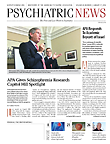The National Institutes of Health (NIH) is looking for imaginative research teams to find better tools and technologies for studying the brain.
The NIH issued Funding Opportunity Announcements (FOAs) last December for six topics as part of the Brain Research Through Advancing Innovative Neurotechnologies (BRAIN) Initiative put forth by President Obama (Psychiatric News, May 3, 2013).
The initiative would give “scientists the tools they need to get a dynamic picture of the brain in action and to better understand how we think and how we learn and how we remember,” said Obama on April 2, 2013. “And that knowledge could be—will be—transformative.”
The requests for proposals were based on a study released last fall by the NIH Advisory Committee to the Director’s BRAIN Working Group that narrowed the initiative’s broader goals (Psychiatric News, October 16, 2013). The NIH wants to see letters of intent by mid-February, full applications by March, and will review proposals over the summer for decisions by September.
The advisory group decided to focus at first on aspects that would affect everyone who studies the brain, including clinicians such as psychiatrists and neurologists.
Two announcements focus on developing methods for classifying and accessing brain cells and circuits, three focus on developing and optimizing technologies for recording and modulating neuronal circuits, and one seeks to develop improved imaging technologies for human research.
“We’ve made remarkable progress over the last decade in understanding how neural circuits work in the human brain and have some idea of how those circuits control mood, anxiety, and fear,” said Story Landis, Ph.D., director of the National Institute of Neurological Disorders and Stroke, in an interview with Psychiatric News. “Now we need a better understanding of the kinds of nerve cells in the brain, and we need tools to interrogate those circuits.”
For instance, current imaging techniques can record changes in blood flow that reflect brain activity, but the BRAIN Initiative would develop methods to directly observe neuronal firing and activity in circuits, said Landis.
The FOAs specifically ask applicants to bring together cross-disciplinary teams to attack the project’s scientific goals. One suggests including researchers from “cellular and systems neuroscience, imaging, material science, nanotechnology, computational and theoretical modeling, bioengineering, physics, chemistry, molecular biology, clinical and behavioral sciences, and other related research areas.”
Landis believes that the field is ready for this approach.
“If we didn’t challenge the scientific community the way the BRAIN team and these FOAs do, I think we wouldn’t be taking advantage of the opportunities that are out there,” she said.
The NIH is not looking for incremental advances. Five of the six FOAs don’t demand any preliminary data, usually a part of research proposals.
“We’re saying: What is the state of the art now, what do you believe you can do, and what’s the rationale for that belief?” said Landis. “You can dream but you have to have a good rationale for what you’re dreaming about.”
In the end, NIH will divide $40 million a year for three years among 49 to 72 awards. In two years or so, the BRAIN Initiative will issue requests for a second round of proposals based on the outcome of the current set of awards.
The current round of Funding Opportunity Announcements includes the following:
Transformative Approaches for Cell-Type Classification in the Brain
Development and Validation of Novel Tools to Analyze Cell-Specific and Circuit-Specific Processes in the Brain
New Technologies and Novel Approaches for Large-Scale Recording and Modulation in the Nervous System
Optimization of Transformative Technologies for Large-Scale Recording and Modulation in the Nervous System
Integrated Approaches to Understanding Circuit Function in the Nervous System
Planning for Next-Generation Human Brain Imaging ■

